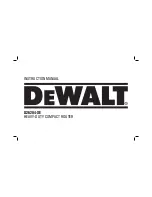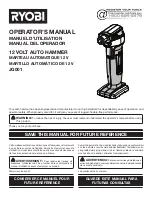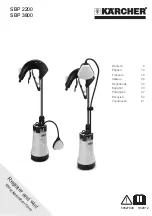
4
• Hearing protection: AS/NZS1270 Acoustics – Hearing Protection;
• Respiratory protection: AS/NZS1716 Respiratory Protective Devices.
WARNING:
Some dust created by power sanding, sawing, grinding, drilling, and
other construction activities contains chemicals known to cause cancer, birth defects
or other reproductive harm. Some examples of these chemicals are:
• lead from lead-based paints,
• crystalline silica from bricks and cement and other masonry products, and
• arsenic and chromium from chemically-treated lumber.
Your risk from these exposures varies, depending on how often you do this type of
work. To reduce your exposure to these chemicals: work in a well ventilated area, and
work with approved safety equipment, such as those dust masks that are specially
designed to filter out microscopic particles.
•
Avoid prolonged contact with dust from power sanding, sawing, grinding,
drilling, and other construction activities. Wear protective clothing and wash
exposed areas with soap and water.
Allowing dust to get into your mouth, eyes,
or lay on the skin may promote absorption of harmful chemicals.
WARNING:
Use of this tool can generate and/or disburse dust, which may cause
serious and permanent respiratory or other injury. Always use approved respiratory
protection appropriate for the dust exposure. Direct particles away from face and
body.
WARNING: Always wear proper personal hearing protection that conforms to
AS/NZS1270 during use.
Under some conditions and duration of use, noise from this
product may contribute to hearing loss.
• The label on your tool may include the following symbols. The symbols and their
definitions are as follows:
V ................. volts
A ...............amperes
Hz ............... hertz
W ..............watts
min ............. minutes
...........alternating current
........ direct current
...........alternating or direct current
.............. Class I Construction
no ..............no load speed
...................
...................
(grounded) n
................rated
speed
•
Be sure that the motor has stopped completely before you lay the router
down.
If the cutter head is still spinning when the tool is laid down, it could cause
injury or damage.
•
Be sure that the router cutter is clear of the workpiece before starting the
motor.
If the cutter is in contact with the workpiece when the motor starts, it
could make the router jump, causing damage or injury.
•
ALWAYS disconnect tool from power source before making adjustments or
changing cutters.
•
Keep hands clear of cutter when motor is running to prevent personal injury.
•
Never touch the cutter immediately after use.
It may be extremely hot.
•
Provide clearance under workpiece for router cutter when through-cutting.
•
Tighten collet nut securely to prevent the cutter from slipping.
•
Never tighten collet nut without a cutter.
•
Do not use router cutters with a diameter in excess of 30 mm in this tool.
•
Avoid Climb-Cutting (cutting in direction opposite than shown in figure 13).
Climb-Cutting increases the chance for loss of control resulting in possible
injury.
When Climb-Cutting is required (backing around a corner), exercise
extreme caution to maintain control of router. Make smaller cuts and remove
minimal material with each pass.
• Always use straight cutters, rabbet cutters, profile cutters, slotter cutters or
grooved knives with a shank diameter of 6–6.35 mm which corresponds to the
size of the collet in your tool.
• Always use cutters suitable for a speed of min. 30000 min
-1
and marked
accordingly.
• Air vents often cover moving parts and should be avoided.
Loose clothes,
jewelry or long hair can be caught in moving parts.
WARNING:
Never use cutters with a diameter exceeding the maximum diameter
indicated in the technical data.
WARNING:
We recommend the use of a residual current device with a residual
current rating of 30mA or less.
WARNING: ALWAYS wear approved protective safety equipment complying with
the following standards:
• Eye protection: AS/NZS1337 Eye Protectors for Industrial Applications;
Summary of Contents for D26204-XE
Page 1: ...D26204 XE HEAVY DUTY COMPACT ROUTER INSTRUCTION MANUAL ...
Page 2: ......
Page 7: ...5 A E D F C B G L J Q FIG 1 ROUND SUBBASE D SUBBASE I K H FIXED BASE M N O P R PLUNGE BASE ...
Page 18: ......
Page 19: ......






































